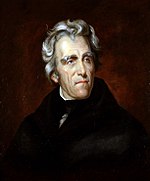United States presidential election, 1824
|
|
|||||||||||||||||||||||||||||||||||||||||||||||||||||||||||||
|---|---|---|---|---|---|---|---|---|---|---|---|---|---|---|---|---|---|---|---|---|---|---|---|---|---|---|---|---|---|---|---|---|---|---|---|---|---|---|---|---|---|---|---|---|---|---|---|---|---|---|---|---|---|---|---|---|---|---|---|---|---|
|
|||||||||||||||||||||||||||||||||||||||||||||||||||||||||||||
|
All 261 electoral votes of the Electoral College 131 electoral votes needed to win |
|||||||||||||||||||||||||||||||||||||||||||||||||||||||||||||
|
|||||||||||||||||||||||||||||||||||||||||||||||||||||||||||||

Presidential election results map. Blue denotes states won by Jackson, orange denotes those won by Crawford, green denotes those won by Adams, light yellow denotes those won by Clay. Numbers indicate the number of electoral votes allotted to each state.
|
|||||||||||||||||||||||||||||||||||||||||||||||||||||||||||||
|
|||||||||||||||||||||||||||||||||||||||||||||||||||||||||||||
James Monroe
Democratic-Republican
John Quincy Adams
Democratic-Republican
The United States presidential election of 1824 was the tenth quadrennial presidential election, held from Tuesday, October 26, to Thursday, December 2, 1824. John Quincy Adams was elected President on February 9, 1825. The election was the only one in history to be decided by the House of Representatives under the provisions of the Twelfth Amendment to the United States Constitution after no candidate secured a majority of the electoral vote. It was also the first U.S. presidential election where the popular vote was reported, and the only presidential election in which the candidate who received a plurality of electoral votes (Andrew Jackson) did not become President, a source of great bitterness for Jackson and his supporters, who proclaimed the election of Adams a corrupt bargain.
Prior to the election, the Democratic-Republican Party had won six consecutive presidential elections. In 1824 the Democratic-Republican Party failed to agree on a choice of candidate for president, with the result that the party effectively ceased to exist and split four ways behind four separate candidates. Later, the faction led by Jackson would evolve into the modern Democratic Party in the 1828 election, while the factions led by Adams and Henry Clay would become the National Republican Party (not related to the current Republican Party) and then the Whig Party.
...
Wikipedia




